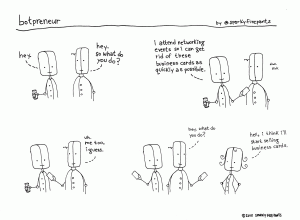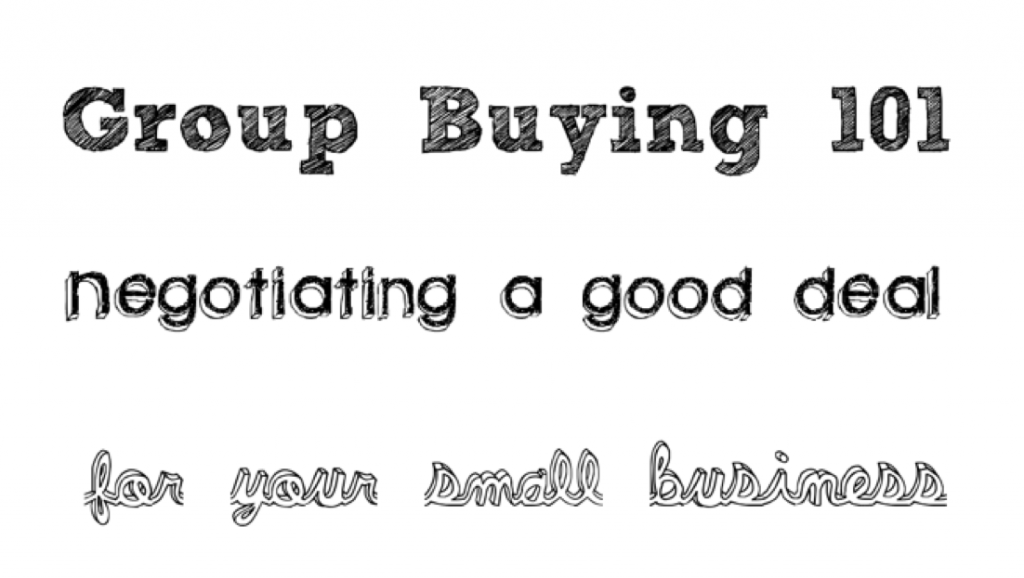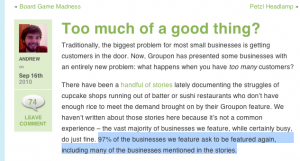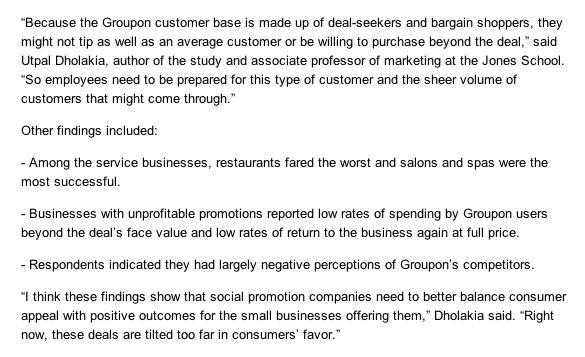Guest Post by David Billings aka Sparky Firepants talented graphic designer, illustrator, creator of the beloved Botpreneur Comic and self-employed genius!

What they’re really thinking when they see your business card
Business card. We put so much thought into this device, we start to lose sight of what they really are: little pieces of card stock with our contact info on them.
It’s so exciting when you get your cards back from the printer, isn’t it? Business toys!
So you pack them carefully in your wallet or Very Special Business Card case from Sky Mall, all ready for your next networking opportunity. You’re just itching to hand one to the first person you see because they are just so damn cool.
Then you do hand it to someone. Without even looking at it twice, they shove it in their pocket. No balloons from the ceiling, no magical aura emanating from their eyeballs. They just kept on talking and now you can’t focus on what they’re saying. You can’t help it. You’re stuck wondering what they thought of your tiny pocket-sized marketing campaign.
I’ll save you the trouble of losing sleep over it. Here’s what they’re really thinking when they see your card:
- How long am I supposed to look at this before putting it in my pocket? I can never remember.
- Dammit. Why did I eat those garlic knots before I came here?
- Oh, crap. Josh needs new soccer cleats. I was supposed to pick them up this afternoon. When can I make my escape?
- These are way better than my cards. My cards suck.
- Oh, wow. This card sucks. Wait. Do mine suck? Oh, no. Mine suck, too. And I just gave out ten of them. Can I get them back and do this over?
Take your pick. They could be thinking about Lady Gaga. Who knows? I do know that they aren’t memorizing your contact info or noticing how everything is fashionably lower case.
Hey. Stop worrying so much about your cards
- You can’t control what they think. Lady Gaga. Enough said.
- Almost everyone thinks their cards suck in some way. Even designers. Um, especially designers.
More important than the best-designed cards on Earth is that human connection you’re making. Focus on that.
You can have the slickest cards in the world, but if you don’t connect with the other person it’s a waste of time and money handing them your card. Not to mention getting theirs.
Hey, do you have a card?
It’s one of the most frequent questions when you meet someone. It’s right up there with “So, what do you do?” It’s like we don’t know how to know a person until we first learn how they earn money and we possess their card.
It’s drilled into your head when you start a business. MUST HAVE BUSINESS CARDS.
I want to challenge this assumption. Do you really need cards?
Think about what happens when you get home from a networking event and you dump all those cards you collected onto your desk. What’s next?
You likely copy the information to your computer. In fact, so many people do this that they even have special biz card scanners and online services that will handle this for you.
And check this out. If we both have iPhones, we can trade contact info without even exchanging paper. In a few years, we’ll probably be able to do this across multi-platform devices.
So why have a card?
Like books and newspapers, people still like holding pieces of written material in their hands. It feels human. Yes, they’re probably gonna toss your card the next day. But in the moment you make a true connection, your card becomes a gift. Literally.
People like getting stuff. Okay, so it’s just a piece of card stock with your contact info on it. Somewhere in our unconscious, we perceive these little pieces of card stock as gifts. It feels good to give them and receive them. Merry Christmas and Happy Hanukkah.
If you don’t have a card your career will not die a painful death. The most important thing is that they have a way to connect with you after you leave. If that means a napkin with your phone number, that’s fine. Just don’t give them a used one.
I do think it’s a good idea to carry cards. But if you gag at the mere idea of the business card game, here’s what you can do to make it more fun, less robotic, and more effective.
- ONLY ONE BUSINESS to a card. Come on, People. Single file. One per customer. I don’t care if you’re a landscaping massage therapist who details cars naked. People get confused. They want to associate one face with one business. Make it simple for them and they’ll like you for it.
- Make your cards useful. There are so many things you can do here. Yoga instructors can put simple positions on the back that anyone can do in their office. I have several different cards with my art on them. Even if you don’t need the info any longer, the art looks nice. Provide info that’s useful on a regular basis. People will have you on top of mind every time they sit down at their desk. Alternatively, put a discount code on the back for one of your services. Give them something they’ll want to keep when they empty their pockets later.
- Hire a professional designer. Measure twice, cut once. Believe it or not, there are actually people out there who study and practice the best layouts for marketing materials. Let’s call them… Graphic Designers. Hire one and stop worrying if you got it right.
- Do it yourself. Well, okay. If you absolutely must do it yourself because you have zero budget, keep it as simple as possible. I’m not going to get into specifics here, but I’ll give you one fab tip: leave out the clipart. I also have an online guide that will help you through it. You can even download a free chapter on DIY right here. http://sparkyfirepants.com/design-prep-questions
- Don’t give your card to just anyone. This goes against conventional wisdom, but hold back. Your cards are special. I know it seems counterintuitive. You created the damn things to give out, right? Seriously. Treat them like cash and don’t devalue your currency. If you’re sticking your card in every sub shop fishbowl to “earn a free lunch,” you’re wasting a resource. You want to give your card to the people you truly resonate with. Even if they don’t need your product or service, it’s more likely they’ll refer people to you who are a good fit.
Remember, not everyone is a potential client or partner. Some people are just nice. In those cases, just give them an email address or URL for your web site.
Use your business toys wisely
Little pieces of card stock can be really handy. Just remember to create them with the receiver in mind. Plan your own personal strategy for how you’ll use your cards and you’ll get the most out of them.












